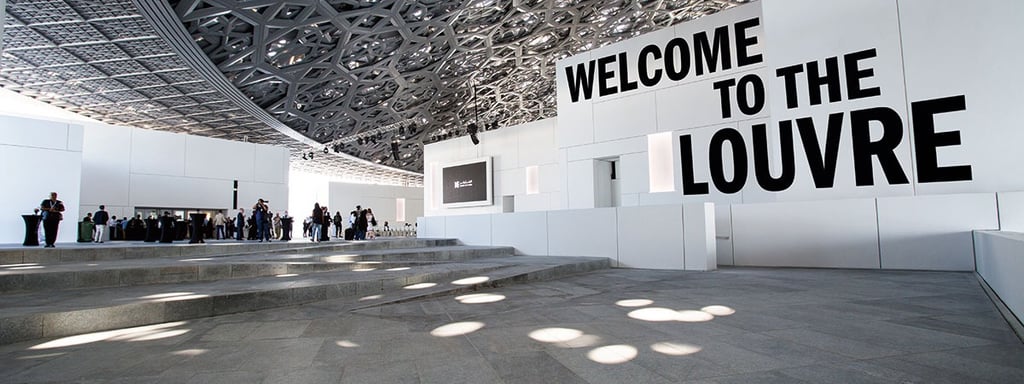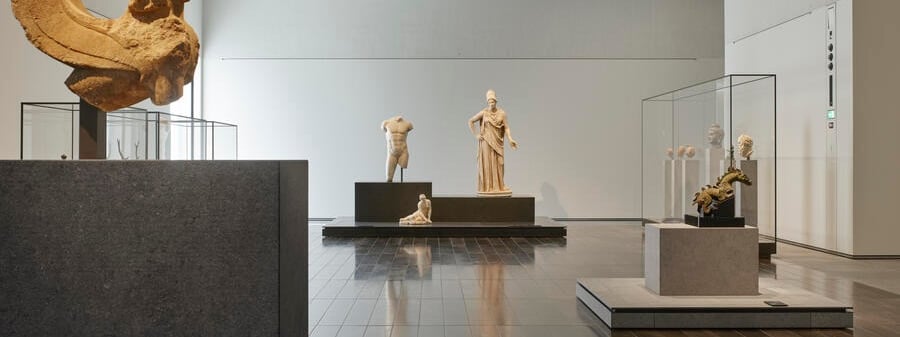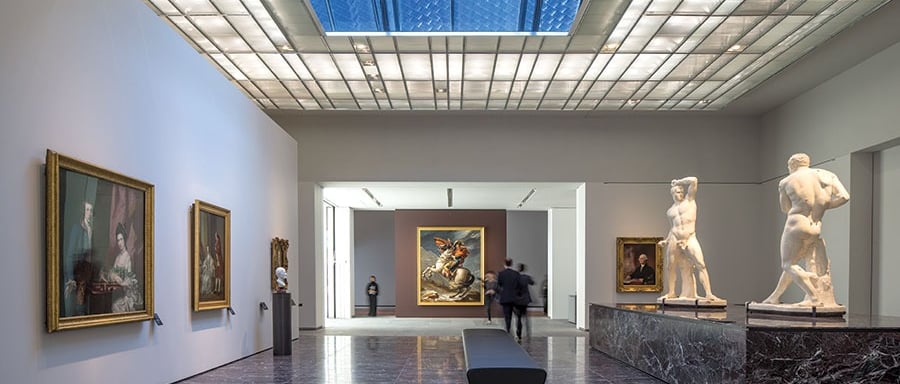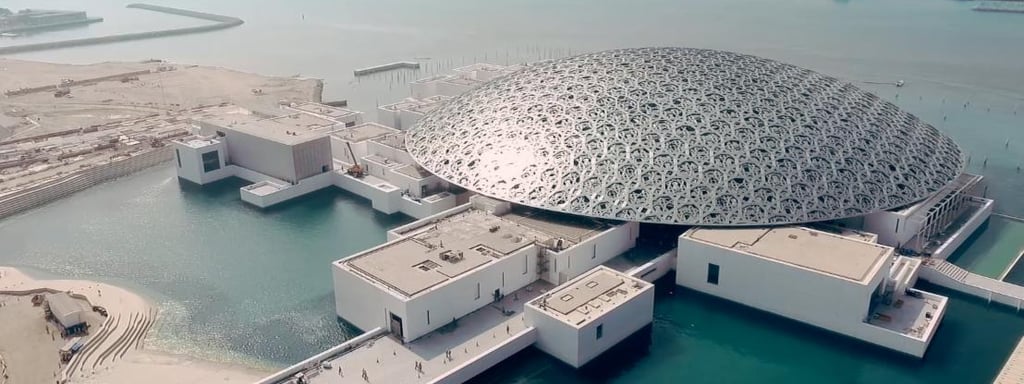Louvre Abu Dhabi
Where architecture becomes poetry and art becomes a journey across civilizations.


The Dome That Floats Over the Sea
In a city where imagination often manifests as shimmering towers and engineered islands, the Louvre Abu Dhabi emerges as something quieter, grander, and infinitely more poetic. Rising gently from the calm waters of Saadiyat Island, it does not scream for attention—it invites you inward. Beneath its silvery dome lies not only a museum but an idea, a space where the stories of civilization breathe freely, unburdened by geography, language, or creed.
The Louvre Abu Dhabi opened its doors in November 2017 as a monument to cultural openness and intellectual curiosity. Conceived as a collaboration between the United Arab Emirates and France, and designed by the renowned architect Jean Nouvel, the museum transcends borders. It is not merely a gallery; it is a living archive of humanity’s universal creativity, presented through a design that is as philosophical as it is architectural.
A Universe Suspended in Geometry
Approaching the museum feels like drifting toward an island from a dream. The main building is a cluster of gleaming white structures, floating like fragments of an ancient city reclaimed by the sea. But it is the dome that captivates instantly—an ethereal lattice of star-shaped openings, spread across an enormous canopy that appears to levitate above the buildings.
Measuring 180 meters in diameter and composed of eight interlocking layers, the dome is not just a roof. It is a celestial presence. Light passes through the intricate web of geometric patterns, creating a dynamic phenomenon Nouvel called the “rain of light.” As the sun arcs across the sky, these filtered beams shift, dancing across water, stone, and people in a choreography that changes with the hour.
This interplay of shadow and shimmer is more than aesthetic—it reflects an Emirati architectural tradition of mashrabiya screens and shaded courtyards, while simultaneously referencing the cosmic awe of Gothic cathedrals. You are not just looking at a building. You are inside a poem.


Galleries Without Borders
The core philosophy of Louvre Abu Dhabi is universality. Unlike traditional museums that separate their collections by culture or region, this museum arranges its galleries thematically and chronologically. Artworks from different times and places are placed side by side, inviting conversations that span continents and millennia.
A Mesopotamian statue might share a room with a Byzantine icon. A Chinese ritual vase may sit near a Picasso sketch. The curators ask you not to separate these works, but to see the continuity—the deep, human threads that weave us together across time and place.
The museum is structured into twelve chapters, or “chapters of humanity,” each one representing a shared aspect of our collective story. These include the origins of the world, the first villages, universal religions, cosmopolitanism, and the modern era. Each gallery is designed with atmospheric lighting, spacious flow, and careful acoustics to allow both introspection and connection.
Over 600 works reside permanently in the collection, with additional masterpieces on loan from institutions such as the Musée d’Orsay, the Centre Pompidou, the Château de Versailles, and the Louvre Museum in Paris. The result is a rotating, evolving narrative that never feels static.
Masterpieces and Quiet Marvels
While the museum hosts iconic pieces—like Leonardo da Vinci’s “La Belle Ferronnière,” Van Gogh’s self-portrait, or Jacques-Louis David’s “Napoleon Crossing the Alps”—many visitors find themselves drawn to the quieter stories. A funerary stele carved with hieroglyphs. A 1,000-year-old Quran placed beside a Torah and a Bible. A 17th-century Japanese scroll whispering tales of nature and spirit. A Chinese bronze mirror. A Bedouin necklace. A contemporary sculpture from Africa reflecting on colonial memory.
What emerges is a sense of continuity. That the human urge to shape, to tell stories, to worship, to question, and to create beauty is not the domain of any one people—it is the very essence of being human.
Each object becomes a mirror. In it, you see not just the past but yourself.


Light, Water, and Silence
The experience of Louvre Abu Dhabi extends beyond the galleries. Water flows between the structures, reflecting sky and dome alike. Footbridges lead you across pools and into shaded passages. The sound of water, the softness of filtered sunlight, and the gentle breeze coming off the Gulf create a kind of sanctuary.
This is not accidental. The museum is designed to be contemplative. It asks for a slower pace. To pause beside a sculpture. To sit beneath the dome and watch the light fall. To hear your own footsteps echo across stone. To feel time loosen.
The exterior is as much part of the experience as the art inside. Walking along the seawall under the dome at sunset is, for many, as moving as standing before a painting by Monet. The building blurs the boundary between architecture and environment, offering the city a rare gift: stillness.
The Children's Museum: Wonder Without Walls
The museum includes a dedicated space for children aged 6 to 12. This is not a place of oversimplified exhibits or cartoons—it is a world crafted for discovery, where curiosity is cultivated through interactive installations, tactile exploration, and storytelling.
Children are encouraged to think like artists, archaeologists, inventors. They are given tools and questions rather than answers. Here, the future of cultural literacy is seeded in joy and play.
The programming changes regularly to reflect new themes and partnerships, ensuring families always find something new to explore.
Temporary Exhibitions and Cultural Pulse
Louvre Abu Dhabi is not a static institution. It pulses with the energy of changing exhibitions, performance art, concerts, and educational events. Themes have included global photography, early modern maps, abstraction, cinema, ancient civilizations, and futuristic design.
These rotating exhibitions often include rare international loans and curated collections that offer fresh perspectives on history and culture. The museum also hosts film screenings, symposia, talks by artists and historians, and festivals that animate the entire site, particularly during winter months.
It is not simply a place to look—it is a place to engage, to learn, to debate.
A Place for Everyone
The museum was conceived as a place of openness, and its design reflects this. Every gallery, courtyard, café, and bridge is wheelchair accessible. Quiet zones offer retreat. Signage is clear and available in multiple languages. Staff are trained not only in information, but in hospitality.
It is a place where art scholars, children, tourists, locals, and curious wanderers are equally welcomed.
This inclusivity extends to its digital platforms as well. Virtual tours, high-resolution artwork archives, educational resources, and artist interviews are all available online, ensuring the museum’s reach transcends its physical walls.


Practical Information for Your Visit
Louvre Abu Dhabi is located on Saadiyat Island, a short drive from downtown Abu Dhabi and well connected by road and public transport. Visitors arriving from Dubai can reach the museum in approximately 90 minutes by car.
The museum is open Tuesday to Sunday and closed on Mondays. Gallery hours typically run from 10:00 AM to 6:30 PM on weekdays, and until 8:30 PM on weekends. The dome area and outside spaces remain open until midnight, allowing visitors to enjoy the architecture in the evening.
Tickets cost around AED 60 for adults, with discounts available for students, children, and UAE residents. Entry is free for children under 13, and for people of determination.
Advance booking is recommended, especially during public holidays or for special events. Guided tours and audio guides are available in several languages. There is also an official app that allows for deeper exploration of artworks, thematic connections, and behind-the-scenes stories.
Onsite facilities include the stylish Fouquet’s restaurant with views of the sea, a museum café, gift shops, and a bookstore. Parking is ample and valet service is available.
Dressing modestly is advised, and comfortable walking shoes will make your experience much more pleasant, given the expansive layout.
Official website: https://www.louvreabudhabi.ae






